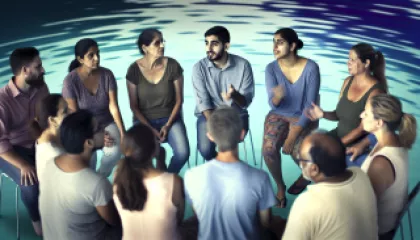How to Start Therapy: A Step-by-Step Guide for Mental Health Education
How to Start Therapy: A Step-by-Step Guide for Mental Health Education
Embarking on the journey of mental health therapy can be both exciting and daunting. Whether you're seeking support for a specific concern or simply wanting to prioritize your overall well-being, navigating the process of starting therapy can feel overwhelming. In this comprehensive guide, we'll walk you through the steps to help you begin your path towards self-improvement and enhanced mental health education.
Understanding the Benefits of Therapy
Before we dive into the practical steps, it's essential to recognize the profound benefits that therapy can offer. Mental health therapy provides a safe, judgment-free space for you to explore your thoughts, emotions, and experiences. Under the guidance of a skilled mental health professional, you can gain valuable insights, develop effective coping strategies, and work towards personal growth and transformation.
Some of the key benefits of engaging in therapy include:
- Improved mental well-being: Therapy can help alleviate symptoms of mental health conditions, such as depression, anxiety, trauma, and stress, allowing you to feel more balanced and resilient.
- Enhanced self-awareness: Through the process of self-exploration and reflection, therapy can deepen your understanding of your thoughts, feelings, and behaviors, empowering you to make informed choices.
- Strengthened relationships: Therapy can help you improve communication, resolve conflicts, and foster healthier, more fulfilling relationships with loved ones.
- Personal growth and development: Therapy provides a supportive environment for you to challenge negative patterns, develop coping mechanisms, and work towards your personal goals and aspirations.
Recognizing the transformative potential of therapy can be the first step in your journey towards improved mental health and well-being.
Assessing Your Needs and Preferences
Before you begin your search for a therapist, it's essential to take the time to reflect on your specific needs and preferences. Consider the following questions to help guide your decision-making process:
- What are your primary concerns or goals for therapy? Are you seeking support for a specific issue, such as anxiety, depression, or relationship challenges, or do you have a broader desire for personal growth and self-improvement?
- What type of therapy or therapeutic approach would you prefer? Different therapists may specialize in various modalities, such as cognitive-behavioral therapy (CBT), psychodynamic therapy, or mindfulness-based interventions. Explore the different approaches to determine what resonates with you.
- Do you have any preferences regarding the therapist's gender, age, or cultural background? Some individuals feel more comfortable working with a therapist who shares certain demographic characteristics or life experiences.
- Are there any practical considerations, such as location, availability, or insurance coverage, that might influence your choice of therapist? Accounting for these factors can help you narrow down your options and find a therapist who is the best fit for your needs and circumstances.
By taking the time to reflect on your preferences and needs, you'll be better equipped to find a therapist who can provide the support and guidance you're seeking.
Researching and Selecting a Therapist
With a clearer understanding of your needs and preferences, you can now begin your search for a suitable therapist. Here are some steps to help you in this process:
Tapping into Your Network
Start by reaching out to your trusted friends, family members, or healthcare providers and ask for recommendations. They may be able to provide valuable insights and personal experiences with therapists in your local area.
Utilizing Online Directories and Databases
Explore online directories and databases, such as those provided by professional organizations or insurance providers, to browse therapists in your region. These resources often include detailed profiles, areas of expertise, and client reviews to help you make an informed decision.
Considering Specializations and Credentials
When reviewing potential therapists, pay attention to their areas of specialization and professional credentials. Look for therapists who have experience and expertise in the specific issues you're seeking to address, as well as those who hold relevant licenses and certifications.
Scheduling Consultations
Once you've identified a few promising options, reach out to schedule initial consultations. Many therapists offer these brief, introductory sessions, either in-person or virtually, to help you assess the fit and determine if you'd like to pursue therapy with them.
During these consultations, be prepared to ask questions and observe how the therapist responds. Consider factors such as their communication style, their ability to actively listen, and the overall rapport you feel. It's essential to find a therapist with whom you feel comfortable and can establish a trusting therapeutic relationship.
Preparing for Your First Therapy Session
After selecting a therapist, the next step is to prepare for your first session. Here are some tips to help you make the most of this initial encounter:
Gather Relevant Information
Before your first session, gather any relevant information or documentation that may be helpful for your therapist to understand your background and current concerns. This could include medical records, previous therapy notes, or a brief written summary of your goals and the issues you'd like to address.
Reflect on Your Expectations
Take some time to reflect on your expectations for therapy. What do you hope to gain from the process? What changes or insights are you seeking? Being clear about your expectations can help you communicate them effectively to your therapist and ensure that you're both working towards the same objectives.
Prepare Questions and Concerns
During your first session, you'll likely have the opportunity to ask questions and address any concerns you may have. Consider preparing a list of questions in advance, such as the therapist's approach to confidentiality, the frequency and duration of sessions, or their communication style.
Cultivate an Open and Honest Mindset
Entering your first therapy session with an open and honest mindset is crucial. Be prepared to share your thoughts, feelings, and experiences openly and truthfully with your therapist. Remember, the therapeutic relationship is built on trust and mutual understanding, and your therapist is there to support and guide you, not to judge or criticize.
What to Expect During the First Therapy Session
The first session is often an opportunity for you and your therapist to get to know each other and establish the foundation for your therapeutic journey. During this initial meeting, you can expect the following:
Introductions and Rapport-Building
Your therapist will likely start by introducing themselves and providing an overview of their professional background and approach to therapy. They may also take the time to understand your reasons for seeking therapy and learn more about your individual needs and goals.
Gathering Background Information
Your therapist will likely ask you a series of questions to gather information about your personal and family history, current life circumstances, and any relevant medical or mental health history. This information helps them develop a comprehensive understanding of your unique situation and needs.
Discussing Confidentiality and Boundaries
Your therapist will explain the limits of confidentiality and the ethical guidelines that govern the therapeutic relationship. This includes discussing any legal or ethical obligations they may have to protect your privacy or report certain information.
Collaborative Goal-Setting
Together with your therapist, you'll have the opportunity to establish clear and achievable goals for your therapy. This collaborative process ensures that you're both working towards the same objectives and that the therapeutic interventions are tailored to your specific needs.
Scheduling and Logistics
Finally, your therapist will likely discuss practical matters, such as the frequency and duration of your sessions, payment and billing, and any other logistical considerations that will shape your ongoing therapeutic experience.
Remember, the first session is a chance for you and your therapist to get to know each other and lay the groundwork for a productive and meaningful therapeutic relationship. Don't hesitate to ask questions or voice any concerns you may have during this initial meeting.
Navigating the Therapeutic Process
As you progress in your therapy journey, you can expect the sessions to become more engaging and impactful. Here are some key elements to keep in mind as you navigate the therapeutic process:
The Importance of Continuity
Consistency and continuity are crucial for the success of your therapy. Attending regular sessions and maintaining open communication with your therapist will help you build trust, deepen your self-exploration, and make meaningful progress towards your goals.
Embracing Vulnerability
Therapy often requires you to be vulnerable and share aspects of your life that you may not have discussed with others. Remember that this vulnerability is a sign of strength and a necessary part of the healing and growth process.
Collaborating with Your Therapist
Your therapist is there to guide and support you, but the success of your therapy ultimately depends on your active participation and collaboration. Be willing to share your thoughts, feelings, and feedback, and work closely with your therapist to develop and implement effective strategies.
Embracing Challenges and Setbacks
It's important to understand that the therapeutic journey may not always be linear. You may encounter challenges, setbacks, or even moments of discomfort as you confront difficult emotions or patterns. Approach these experiences with self-compassion and a willingness to explore and learn from them.
Practicing Self-Care and Integration
Engaging in therapy is a significant investment of time and emotional energy. Prioritize self-care practices, such as getting enough sleep, engaging in regular exercise, and practicing stress-management techniques, to support your overall well-being throughout the process.
Additionally, take the insights and skills you've gained in therapy and integrate them into your daily life. This can help you reinforce the progress you've made and continue to foster personal growth and transformation.
Concluding Your Therapy Journey
As you near the end of your therapy journey, it's important to approach the termination process with intentionality and care. Here are some considerations for concluding your therapeutic relationship:
Evaluating Progress and Celebrating Achievements
Take the time to reflect on the progress you've made throughout your therapy experience. Acknowledge the personal growth, insights, and coping strategies you've developed, and celebrate the successes you've achieved along the way.
Discussing Termination and Transition
Work closely with your therapist to discuss the appropriate timing and process for terminating your sessions. This might involve gradually reducing the frequency of your meetings or developing a plan for maintaining your progress and mental health after therapy.
Exploring Ongoing Support and Resources
As you prepare to conclude your therapy journey, your therapist may provide you with recommendations for ongoing support, such as support groups, community resources, or referrals to other mental health professionals. This can help you maintain the momentum you've built and continue your personal growth journey.
Expressing Gratitude and Closure
Finally, take the time to express your gratitude to your therapist for their guidance and support throughout the process. This can be an opportunity to reflect on the significance of your therapeutic relationship and find a sense of closure as you transition to the next chapter of your life.
Conclusion
Starting therapy can be a transformative and empowering experience, but it's normal to feel apprehensive or uncertain about the process. By understanding the benefits of therapy, assessing your needs and preferences, and taking the necessary steps to find the right therapist, you can embark on a journey of personal growth, self-discovery, and improved mental health.
Remember, the therapeutic process is a collaborative effort, and your active participation and willingness to be vulnerable are key to its success. Embrace the challenges, celebrate the victories, and trust that with the guidance of a skilled mental health professional, you can cultivate the insights, coping strategies, and self-awareness needed to enhance your overall well-being.
Embarking on the path of therapy is a courageous and meaningful step towards a healthier, more fulfilling life. With this step-by-step guide, you now have the tools and knowledge to begin your journey towards therapy for self-improvement and mental health education. May this guide serve as a valuable resource as you navigate the transformative world of therapy and unlock your full potential.






